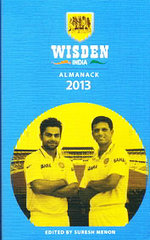Wisden India Almanack 2013
David Mutton |Published: 2013
Pages: 755
Author: Menon, Suresh (Editor)
Publisher: Bloomsbury
Rating: 2.5 stars

A Wisden India Almanack is an idea whose time has indisputably arrived. It makes sense from both a commercial and a cricketing perspective; the game’s soul having migrated to the subcontinent but with no annual publication on the nation’s cricketing affairs since Indian Cricket was put into pasture almost a decade ago.
Unfortunately a sensible idea does not always lead to a good product. Building a new institution is bound to be difficult but Wisden India’s inaugural edition is frustratingly patchy and without a clear identity. No explanation is given for the addition of a sixth cricketer of the year to the original formula, while sections on Bangladesh, Sri Lanka, and Pakistan make it feel more of an Asian than an Indian Almanack. Most concerning is the reliance on the big brother, Wisden Cricketers’ Almanack, for content, with the books and obituaries sections largely distilled versions of Wisden 2012.
The high point of the Almanack is its Comment section, which features several beautiful articles, many of which include the leitmotif of the passing of India’s most successful generation. Rahul Bhattacharya’s piece offers a nostalgic elegy for Ganguly’s heroic team, while Anand Vasu provides an insight into the new crop of players aspiring to an IPL contract. Outside of Indian cricket, Shehan Karunatilaka’s brilliant portrait of Muttiah Muralitharan distills the essence of the maestro’s meaning for both his sport and his nation into a few pages, and the ever-excellent Gideon Haigh writes admiringly of Mahela Jayawardene and Kumar Sangakarra. .
Unfortunately even these strong suits are marred by the most surprising weakness in Wisden India, its slapdash copy editing. It must be embarrassing for several typos and spacing errors to creep into a Wisden publication; it is surely mortifying that four paragraphs in Richard Sydenham’s piece on spot-fixing are duplicated. It is hard to understand how such mistakes found there way into the final edition and, more than most books, it is eats away at its authority.
At 755 pages Wisden India comes in at under half the size of its older sibling. This is principally due to a reduced records section, which Suresh Menon explains in his editor?s notes has now been overtaken on a daily basis by websites devoted to the game. That seems fair enough but more frustrating is the compressed details of domestic cricket. There are details of all the significant matches on the subcontinent but it would be useful to read summaries of at least the first class games which are instead reduced to just five or six lines per match (tellingly the IPL games receive more comprehensive coverage).
Menon notes that it is the second year that will be the hardest. Wisden India is staffed by a talented team, with an experienced leader in Menon. But its second year will not just be harder, it needs to be substantially better in order that Wisden India develops into the sustainable and independent publication that Indian cricket deserves.






Leave a comment